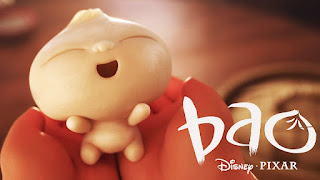Short film research: Bao
In the short film "Bao," the filmmakers make use of a variety of camera angles, shots, editing techniques, and mis-en-scène elements to create a visually striking and emotionally impactful story. One notable aspect of the film's cinematography is the use of close-up shots to highlight the emotions of the characters and to draw the viewer's attention to specific details. For example, close-up shots of the mother's face are used to show her love and affection for the dumpling, as well as her sadness and loneliness when it leaves her. The film also makes use of overhead shots to show the relationships between characters and their environment. These shots allow the viewer to see the layout of the mother's kitchen and the dumpling's interactions with the objects around it. In terms of editing, "Bao" makes use of cutaways and flashbacks to help convey the passage of time and to provide context for the story. For example, the film uses cutaways to show the mother's memories of her own childhood and her relationship with her mother. In terms of mis-en-scène, "Bao" uses a variety of elements to create a realistic and immersive world for its characters. This includes the use of set design and props to recreate a Chinese-Canadian kitchen, as well as the use of costume and makeup to convey the characters' personalities and emotions. Overall, the filmmakers of "Bao" use a variety of cinematic techniques to create a visually striking and emotionally powerful film. These techniques help to bring the characters and their story to life and to engage the viewer in the film's themes and narrative.


Comments
Post a Comment